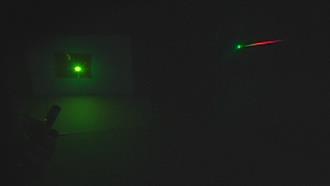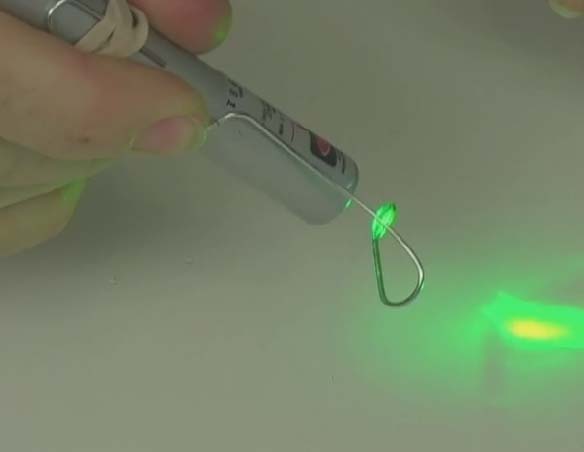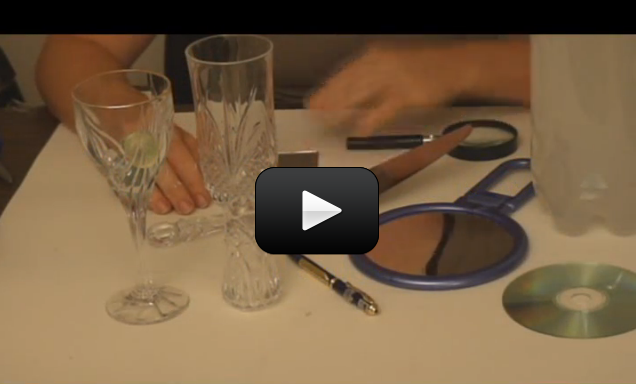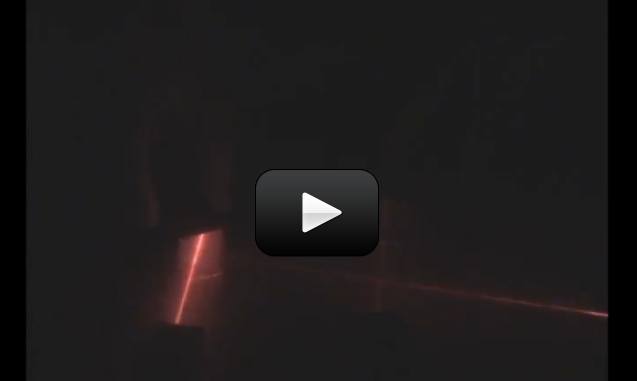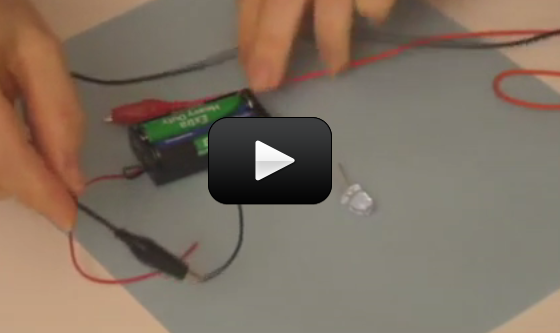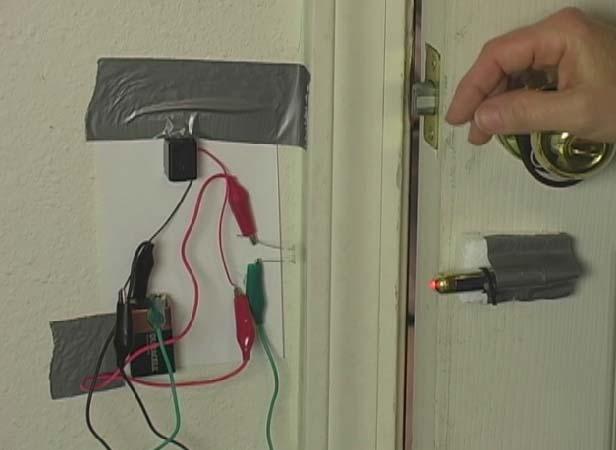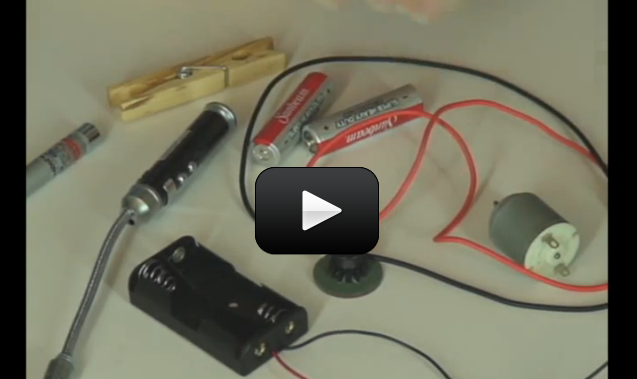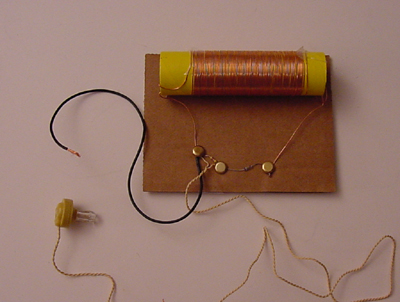If you’ve ever wondered how glow in the dark toys stay bright even in the dark, this activity is just for you! When light hits a material, it’s either reflected, transmitted, or absorbed as we discovered with the gummy bear activity earlier. However, certain materials will absorb one wavelength and emit an entirely different wavelength, and when this happens it’s called “fluorescence”. Let’s do an experiment first, and then we’ll go over why it does what it does.
[am4show have=’p8;p9;p99;’ guest_error=’Guest error message’ user_error=’User error message’ ]
Materials
- Laser (green)
- Highlighter (pink or orange)
- Diffraction grating
- White paper
- Point your laser at the wall, making a bright green dot. (Red lasers won’t work with this experiment.)
- Look at the dot through the diffraction grating. What do you see? How many different colors are there? (If you don’t have a diffraction grating, then simply shine your laser onto a CD and look at the reflected beams.)
We’ll do more on diffraction another time, but just note that a diffraction grating is made up of a lot of tiny prisms that un-mix light into its different colors. That’s why you see several different dots coming from the laser when you pass it through the diffraction grating. If you look at a candle flame through a diffraction grating, you’ll see a whole rainbow, since the white light from a candle is made up of the rainbow. (Image below is a laser through a diffraction grating.) A laser is one color, monochromatic , so you should expect to see only one color through the diffraction grating.
Now let’s try something else…
- On your white sheet of paper, color an area with your marker.
- Hold the paper against the wall. You can tape it into place if that makes it easier.
- Turn off the lights and point a green laser at the highlighter area you colored in.
- Look at the dot next to the main dot through the diffraction grating.
- Do you see more than one color now? Whoa!
This is a fantastic experiment because it gives you totally unexpected results! Where did the colors come from when you shined your laser on the highlighter area? And why weren’t they present when you just used a plain white wall?
It has to do with something called fluorescence. When the green laser hits the orange square, the electrons are excited by the laser and jump up to a higher energy state, and then relax back down. When they relax down, they release photons (light particles) that are made up of several different wavelengths. The diffraction grating makes it possible to see those wavelengths individually as a spectrum.
[/am4show]
Do you have thick or thin hair? Let’s find out using a laser to measure the width of your hair and a little knowledge about diffraction properties of light. (Since were using lasers, make sure you’re not pointing a laser at anyone, any animal, or at a reflective surface.)
[am4show have=’p8;p9;p19;p46;p89;p99;’ guest_error=’Guest error message’ user_error=’User error message’ ]
Light is also called “electromagnetic radiation”, and it can move through space as a wave, which makes it possible for light to interact in surprising ways through interference and diffraction. This is especially amazing to watch when we use a concentrated beam of light, like a laser.
If we shine a flashlight on the wall, you’ll see the flashlight doesn’t light up the wall evenly. In fact, you’ll probably see lots of light with a scattering of dark spots, showing some parts of the wall more illuminated than the rest. What happens if you shine a laser on the wall? You’ll see a single dot on the wall.
In this experiment, we used a laser to discover how interference and diffraction work. We can use diffraction to accurately measure very small objects, like the spacing between tracks on a CD, the size of bacteria, and also the thickness of human hair.
Here’s what you need:
- a strand of hair
- laser pointer
- tape
- calculator
- ruler
- paper
- clothespin
WARNING! The beam of laser pointers is so concentrated that it can cause real damage to your retina if you look into the beam either directly or by reflection from a shiny object. Do NOT shine them at others or yourself.
Download Student Worksheet & Exercises
- Tape the hair across the open end of the laser pointer (the side where the beam emits from)
- Measure 1 meter (3.28 feet) from the wall and put your laser right at the 1 meter mark.
- Clip the clothespin onto the laser so that it keeps the laser on.
- Where the mark shows up on the wall, tape a sheet of paper.
- Mark on the sheet of paper the distance between the first two black lines on either side of the center of the beam.
- Use your ruler to measure (in centimeters) to measure the distance between the two marks you made on the paper. Convert your number from centimeters to meters (For me, 8 cm = 0.08 meters.)
- Read the wavelength from your laser and write it down. It will be in “nm” for nanometers. My laser was 650 nm, which means 0.000 000 650 meters.
- Calculate the hair width by multiplying the laser wavelength by the distance to the wall (1 meter), and divide that number by the distance between the dark lines. Multiply your answer by 2 to get your final answer. Here’s the equation:
Hair width = [(Laser Wavelength) x (Distance to Wall)] / [ (Distance between dark lines) x 0.5 ]
In the video:
- wavelength was 650 nm = 0.000 000 650 meters
- distance from the wall was 1 meter
- the distance between the dark lines was 8 cm = 0.08 m
Using a calculator, this gives a hair width of 0.000 0162 5meters, or 16.25 micrometers (or 0.000 629 921 26 inches). Now you try!
What’s Going On?
The image here shows how two different waves of light interact with each other. When a single light wave hits a wall, it shows up as a bright spot (you wouldn’t see a “wave”, because we’re talking about light).
When both waves hit the wall, if they are “in phase”, they add together (called constructive interference), and you see an even brighter spot on the wall.
If the waves are “out of phase”, then they subtract from each other (called “destructive interference”) and you’d see a dark spot. In advanced labs, like in college, you’ll learn how to create a phase shift between two waves by adding extra travel length to one of the waves along its path.
So why are there dark lines along the light line when you shine your laser on the hair in this experiment? It has to do with something called “interference”.
One kind of interference happens when light goes through a small and narrow opening, called a slit. When light travels through a single slit, it can interfere with itself. This is called diffraction.
When light travels through one of two slits, it can interfere with light traveling through the other slit, a lot like how water ripples can interfere with each other as they travel over the surface of water.
If you’re wondering where the slit is in this experiment, you’re right! There’s no narrow opening that light it traveling through. in fact, light appears to be traveling around something, doesn’t it? Light from the laser must travel around the hair to get to the wall. The way that light does this has to do with Babinet’s Principle, which relates the opposite of a slit (a small object the size of a slit) to the slit itself.
It turns out amazingly enough that when light hits a small solid object, like a piece of hair, it creates the same interference pattern as if the hair were replaced with a hole of the same size. This idea is called Babinet’s Principle.
By measuring the diffraction pattern on the wall, we can measure the width of a small object that the light had to travel around by measuring the dark lanes in the spot on the wall. In our lab, the small object is a piece of your hair!
Questions to Ask:
- What would happen to the diffraction pattern if the hair width was smaller?
- Using this experiment, how can you tell if the hair is round or oval?
- If we redid these experiments with a different color laser instead of red, what changes would you have needed to make?
- How can you modify this experiment to measure the width of a track on a CD? Does the track width change as a function of location on the CD? If so, is it larger or smaller near the outside?
Exercises
- Which light source gave the most interesting results?
- What happens when you aim a laser beam through the diffraction grating?
- How is a CD different and the same as a diffraction grating?
- Why does the feather work?
[/am4show]
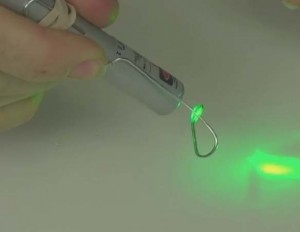 Did you know that you can use a laser to see tiny paramecia in pond water? We’re going to build a simple laser microscope that will shine through a single drop of water and project shadows on a wall or ceiling for us to study.
Did you know that you can use a laser to see tiny paramecia in pond water? We’re going to build a simple laser microscope that will shine through a single drop of water and project shadows on a wall or ceiling for us to study.
[am4show have=’p8;p9;p99;’ guest_error=’Guest error message’ user_error=’User error message’ ]
Here’s how it works: by shining a laser though a drop of water, we can see the shadows of objects inside the water. It’s like playing shadow puppets, only we’re using a highly concentrated laser beam instead of a flashlight.
If you’re wondering how a narrow laser beam spreads out to cover a wall, it has to do with the shape of the water droplet. Water has surface tension, which makes the water want to curl into a ball shape. But because water’s heavy, the ball stretches a little. This makes the water a tear-drop shape, which makes it act like a convex lens, which magnifies the light and spreads it out:
Here’s how to make your own laser microscope:
Materials:
- red or green laser (watch video for laser tips)
- large paperclip
- rubber band
- stack of books
- white wall
- pond water sample (or make your own from a cup of water with dead grass that’s been sitting for a week on the windowsill)
Download Student Worksheet & Exercises
Exercises
- Does this work with other clear liquids?
- What kind of lens occurs if you change the amount of surface tension by using soapy water instead?
- Does the temperature of the water matter? What about a piece of ice?
- Does this work with a flashlight instead of a laser?
- Do lasers hurt your eyes? How?
[/am4show]
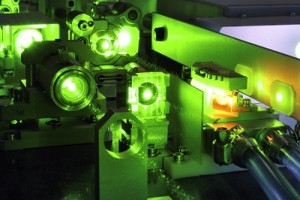 Click here for a printer-friendly version of this page.
Click here for a printer-friendly version of this page.
Objective You will learn about light waves and optics in this Laser Lab. Kids will play with their lasers and see what happens when they shine it on and through different objects.
Laser Safety Before we start our laser experiments, you’ll need eye protection – tinted UV ski goggles are great to use, as are large-framed sunglasses, but understand that these methods of eye protection will not protect your eyes from a direct beam. They are intended as a general safety precaution against laser beam scatter. (If you’re using a Class I or II laser, you don’t need to wear the goggles – but it is a good habit to get the kids into, so it’s up to you.)
About the Experiment This lab is an excellent opportunity for kids to practice asking better questions. Don’t worry too much about academics at this point – just give them a box of materials and let them figure these things out on their own. One of the neat things you can do is ask the kids some questions about what they are doing.
For example, when they shine their laser on a window, you’ll see part of the beam pass through while another part gets reflected back… now why is that? And why does the CD produce so many different reflections? Sometimes these reflections are hard to find actually seeing the beam itself. While red lasers are impossible to see with the naked eye, you can make your beam visible by doing your experiments in a steamy dark bathroom (after a hot shower).
The How and Why The word “LASER” stands for Light Amplification by Stimulated Emission of Radiation. A laser is an optical light source that emits a concentrated beam of photons. Lasers are usually monochromatic – the light that shoots out is usually one wavelength and color, and is in a narrow beam.
By contrast, light from a regular incandescent light bulb covers the entire spectrum as well as scatters all over the room. (Which is good, because could you light up a room with a narrow beam of light?)
There are about a hundred different types of atoms in the entire universe, and they are always vibrating, moving, and rotating. When you add energy to an atom, it vibrates faster and moves around a lot more. When the atoms relax back down to their “normal” state, they emit a photon (a light particle). A laser controls the way energized atoms release photons.
Imagine kids zooming all over the playground, a mixture of joy and chaos. Light from an incandescent light bulb works the same way – the bulb emits high energy photons that bounce all over the place. Can you round up the kids and get them to jumping in unison? Sure you can – just hit the play button on a song, and they’ll be clapping and stamping together. You can do the same with light – when you focus the energy into a narrow beam, it’s much more powerful than having it scattered all over the place. That’s just what a laser is – a high-energy, highly-focused beam of light.
Questions to Ask When you’ve worked through most of the experiments ask your kids these questions and see how they do:
- What does LASER stand for?
- How is a laser different from an incandescent bulb?
- What are two things that can split a laser beam?
- How do you make a laser beam visible?
- What’s the secret behind the laser light show?
- How do lasers damage things?
How many of these items do you already have? We’ve tried to keep it simple for you by making the majority of the items things most people have within reach (both physically and budget-wise).
You do not need to do ALL the experiments – just pick the ones you want to do! Look over the experiments and note which items are needed, and off you go!
Click here for a printer-friendly version of this page.
NOTE: Radio Shack part numbers have been replaced. Click here for full chart.
Materials
Materials for the Laser Light Show
- Red laser pointer
- Old CD you can scratch
- 5-6 small mirrors (like mosaic mirrors from a craft store)
- Ice cube
- Window
- Feather
- 3 large paper clips
- 10 brass fasteners
- Index card
- Cardboard
- Rubber band or zip tie
- Scissors
- Tape
- Two 3V DC motors
- Two AA battery packs
- Four AA batteries
- Three alligator wires
- Optional: plastic gem pieces
Materials for the Flashlight-Laser Tag, Laser Burglar Alarm, Door Alarm
- Red laser pointer (NOT GREEN!)
- 2 AA batteries
- Old pair of headphones (you need the plug section)
- Computer OR laptop OR portable amplifier
- CdS Cell
- One AA battery holder
- PNP Transistor 2N3906 or 2N4403
- NPN Transistor 2N3904 or 2N222A
- LED
- 4.7k-ohm resistor
- Soldering equipment or breadboard
- Optional: NC (normally-closed) switch
Materials for Crystal Radio Project: (This is a battery-free radio!)
- Toilet paper tube
- Magnet wire
- Germanium diode: 1N34A
- 4.7k-ohm resistor
- Alligator clip test leads
- 100’ stranded insulated wire (for the antenna)
- Scrap of cardboard
- Brass fasteners (3-4)
- Telephone handset or get a crystal earphone
Did you know that the word LASER stands for Light Amplification by Stimulated Emission of Radiation? And that a MASER is a laser beam with wavelengths in the microwave part of the spectrum? Most lasers fire a monochromatic (one color) narrow, focused beam of light, but more complex lasers emit a broad range of wavelengths at the same time.
In 1917, Einstein figured out the basic principles for the LASER and MASER by building on Max Planck’s work on light. It wasn’t until 1960, though when the first laser actually emitted light at Hughes Research Lab. Today, there are several different kinds of lasers, including gas lasers, chemical lasers, semiconductor lasers, and solid state lasers. One of the most powerful lasers ever conceived are gamma ray lasers (which can replace hundreds of lasers with only one) and the space-based x-ray lasers (which use the energy from a nuclear explosion) – neither of these have been built yet!
[am4show have=’p8;p9;p19;p46;p99;’ guest_error=’Guest error message’ user_error=’User error message’ ]
Gas lasers pump different types of gases to get different laser colors such as the red HeNe (Helium-Neon laser), the high-powered CO2 lasers that they can melt through metal, the blue-green argon-ion, the UV lasers that use nitrogen, and the metallic-gas combination such as He-Ag lasers (helium and silver) and Ne-Cu (neon and copper) which emit a deep violet beam.
But what about lasers used everyday? The lasers we’re going to be using are semiconductor lasers that use a small laser diode to emit a beam. They are the same lasers that are in the grocery store scanners, pen laser pointers and key chain lasers. Usually a class I or II laser, these pose minimal safety risk and are safe to use in our experiments. Here’s what you need to know:
Materials:
- laser (A key-chain laser works great. Do NOT use green lasers, which can only be used outdoors.)
- dark room
- old CD
- cut-crystal (wine glasses, fancy vases, etc) with adult help
- microscope slide or window
- cellophane and nail polish (red, green, and blue are optimal and used again in the Light Wave experiments)
- feather
- two pairs of polarized sunglasses
- frosted incandescent light bulb
Before we start building our laser projects, just play with it first. Turn off the lights at night and take your laser on a hunt around the house to see what happens when you shine it on or through different things. Here are some ideas to try:
1. Shatter the Beam: Shine your beam over the surface of an old CD. Does it work better with a scratched or smoother surface? You should see between 5-13 reflections off the surface of the CD, depending on where you shine it and how well the “seeing” conditions are.
2. Beam Scatter: Pass the laser beam through several cut-crystal objects such as wine glasses or clear glass vases. Is there a difference between clear plastic or glass, smooth or multi-faceted? Try an ice cube, both frosted and wet (clear).
3. Split the Beam: Shine the laser beam through a flat piece of glass, such as a window. Can you find the pass-through beam as well as a reflected beam? Windows and clear plastic containers will split your beam in two.
What’s going on? When you shine your laser beam through glass (like a window) or plastic (like a soda bottle filled with water and a tiny bit of cornstarch), it splits into two beams – one that passes through, and the other that internally reflects back. You can see these reflections in a darkened fog-filled room.
4. Colored Filters: Paint a piece of cellophane or stiff clear plastic with nail polish (or use colored filters) to put in the laser beam.
5. Diffraction Grating: You can make a quick diffraction grating by using a feather in the beam.
6. Polarization: If you have polarizer filters, use two. You can substitute two pairs of sunglasses. Just make sure they are polarized lenses (most UV sunglasses are). Place both lenses in the beam and rotate one 90 degrees. The lenses should block the light completely in one configuration and allow it to pass-through the other way.
Why does this happen? Polarization is a way of filtering light. Try this: in a shallow pan filled with water, make a few waves and notice how they travel from one side of the pan to the other. Now add a plastic comb, and notice how the waves stop when they hit the comb – not many pass through to the other side (watch out for the waves that creep around the edges – we’re focusing on the pass-through waves only). The comb are the sunglasses, and the water waves are the light waves.
Add a second comb at 90 degrees from the first (as you did with the sunglasses) so it resembles a mesh screen, and notice now how NONE of the waves make it through the comb array. Polarization can filter out various amounts of light, depending on the angle the combs make with each other (90 degrees apart equals total block-out).
7. Light Bulbs: In the dark, aim your laser at a frosted incandescent light bulb. The bulb will glow and have several internal reflections! What other types of light bulbs work well?
Learn more! Read up about lasers here.
[/am4show]
By using lenses and mirrors, you can bounce, shift, reflect, shatter, and split a laser beam. Since the laser beam is so narrow and focused, you’ll be able to see several reflections before it fades away from scatter. Make sure you complete the Laser Basics experiment first before working with this experiment.
You’ll need to make your beam visible for this experiment to really work. There are several different ways you can do this:
[am4show have=’p8;p9;p19;p46;p89;p99;’ guest_error=’Guest error message’ user_error=’User error message’ ]
1. Take your laser with you into a steamy bathroom (which has mirrors!) after a hot shower. The tiny droplets of water in the steam will illuminate your beam. (Psst! Don’t get the laser wet!)
2. If you have carpet, shine your laser under the bed while stomping the floor with your hand. The small particles (dust bunnies?) float up so you can see the beam. Some parents aren’t going to like this idea, sooo….
3. Drop a chunk of dry ice (use gloves!) into a bowl of water and use the fog to illuminate the beam. The drawback to this is that you need to keep adding more dry ice as it sublimates (goes from solid to gas) and replacing the water (when it gets too cold to produce fog).
Materials:
- large paper clips
- brass fastener
- index card
- small mirrors (mosaic-type work well)
Download Student Worksheet & Exercises
Here’s what you do: Open up each paper clip into the “L” shape. Insert a brass fastener into one U-shape leg and punch it through the card. Hot glue (or tape) one square mirror to the other end of the L-bracket. Your mirror should be upright and able to rotate. Do this with each mirror. (You can alternatively mount each mirror to a one-inch wooden cube as shown in the video.)
Turn on the laser adjust the mirrors to aim the beam onto the next mirror, and the next! Turn down the lights first and use any one of the methods mentioned above to make your laser beam visible.
What’s happening? The mirrors are bouncing the laser beam to each other, and the effect shows up when you dim the lights and add fog or dust particles to help illuminate the beam. A laser beam is a highly focused beam of light, and you can direct that light and bounce it off mirrors!
Why can’t I see the beam normally? The reason you can’t see the laser beam without the help of a steamy room, dirty carpet, or fog machine is that your eyes are tuned for green light, not red (which is why you can see the beam from a green laser at night).
Exercises
- The word LASER is actually an acronym. What does it stand for?
- What type of laser did we use in our experiment?
- Why can’t we see the laser beams without the help of steam, dirty carpet, etc.?
[/am4show]
Lasers are cool, but what can you do with one? This is a great introductory activity into what lasers are, how they work, and how different mediums (like glass, feathers, mirrors, etc.) can change the direction of the beam.
Lasers are a monochromatic (one color) concentrated beam of light. This means that when compared with a flashlight, the laser delivers more punch on a light detector. The alignment is more critical (as you’ll find out when you zig-zag a laser through several mirrors), so take your time and do these experiments in a steamy, dark bathroom after a hot shower. That way, you’ll be able to see the beam and align your optics easily.
[am4show have=’p8;p9;p99;’ guest_error=’Guest error message’ user_error=’User error message’ ]
Are you ready to build your own laser theater? Here’s what you need:
- Red laser pointer (NOT GREEN!)
- 2-3 small mirrors (like mosaic mirrors)
- Feather
- 3 large paper clips
- 10 brass fasteners
- Index card
- Cardboard
- Rubber band or zip tie
- Steamy dark bathroom room (like after a hot shower with the windows covered)
- Two 3V DC motors
- Two AA battery packs
- Four AA batteries
- Three alligator wires
- Optional: plastic gem pieces
[/am4show]
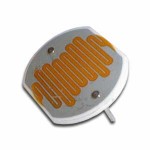 This is a super-cool and ultra-simple circuit experiment that shows you how a CdS (cadmium sulfide cell) works. A CdS cell is a special kind of resistor called a photoresistor, which is sensitive to light.
This is a super-cool and ultra-simple circuit experiment that shows you how a CdS (cadmium sulfide cell) works. A CdS cell is a special kind of resistor called a photoresistor, which is sensitive to light.
A resistor limits the amount of current (electricity) that flows through it, and since this one is light-sensitive, it will allow different amounts of current through depends on how much light it "sees".
Photoresistors are very inexpensive light detectors, and you'll find them in cameras, street lights, clock radios, robotics, and more. We're going to play with one and find out how to detect light using a simple series circuit.
Materials:
- AA battery case with batteries
- one CdS cell
- three alligator wires
- LED (any color and type)
[am4show have='p8;p9;p20;p47;p108;p76;p89;p97;p99;' guest_error='Guest error message' user_error='User error message' ]
Download Student Worksheet & Exercises
Turn this into a super-cool burglar alarm!
Exercises
- How is a CdS cell like a switch? How is it not like a switch?
- When is the LED the brightest?
- How could you use this as a burglar alarm?
[/am4show]
 This is a super-cool and ultra-simple circuit experiment that shows you how a CdS (cadmium sulfide cell) works. A CdS cell is a special kind of resistor called a photoresistor, which is sensitive to light.
This is a super-cool and ultra-simple circuit experiment that shows you how a CdS (cadmium sulfide cell) works. A CdS cell is a special kind of resistor called a photoresistor, which is sensitive to light.
A resistor limits the amount of current (electricity) that flows through it, and since this one is light-sensitive, it will allow different amounts of current through depends on how much light it "sees".
Photoresistors are very inexpensive light detectors, and you'll find them in cameras, street lights, clock radios, robotics, and more. We're going to play with one and find out how to detect light using a simple series circuit.
Materials:
- AA battery case with batteries
- one CdS cell
- three alligator wires
- LED (any color and type)
[am4show have='p8;p9;p20;p47;p108;p76;p89;p97;p99;' guest_error='Guest error message' user_error='User error message' ]
Download Student Worksheet & Exercises
Turn this into a super-cool burglar alarm!
Exercises
- How is a CdS cell like a switch? How is it not like a switch?
- When is the LED the brightest?
- How could you use this as a burglar alarm?
[/am4show]
This is a beefier-version of the Electric Eye that will be able to turn on a buzzer instead of a LED by increasing the voltage in the circuit. This type of circuit is a light-actuated circuit. When a beam of light hits the sensor (the "eye"), a buzzer sounds. Use this to indicate when a door closes or drawer closes... your suspect will never know what got triggered.
[am4show have='p8;p9;p99;p108;' guest_error='Guest error message' user_error='User error message' ]
Materials:
- Red laser (cheap dollar store kind works well)
- 9V Battery
- Three alligator clip leads
- Buzzer (3-6V)
- CdS Cell
Download Student Worksheet & Exercises
Exercises
- How is this circuit different from the Electric Eye experiment we did previously?
- Name three other light sources that work to activate your circuit.
[/am4show]
If you've already made the Laser Burglar Alarm (which is highly recommend doing FIRST), then you're probably wondering how to make the circuit act in the opposite way... meaning how do you make it so that the buzzer sounds when the light is turned off?
This circuit requires more patience and parts, but it's totally worth it. It uses the same parts as the previous experiment (plus a few more) with a couple of extra twists and turns in the circuit to let the buzzer know when it's time to turn off. Use this in doorways or as an invisible trip wire trigger across hallways.
Materials:
- Red laser pointer
- 9V battery or two AA's in a AA battery pack
- 7 alligator clip leads
- CdS Cell
- 9V Battery OR 2 AA's in a battery holder
- NPN Transistor 2N3904 or 2N222A
- 4.7k-ohm resistor
- Buzzer (3-6V)
[am4show have='p8;p9;p98;p99;p108;' guest_error='Guest error message' user_error='User error message' ]
Why bother with the transistor? The Electric Eye & the Burglar Alarm didn't have one! The reason you can't simply substitute a buzzer for the LED in the electric eye is that the buzzer draws much more current than the CdS cell supplies. We overcame this issue in the Burglar Alarm by increasing the voltage from 3V to 9V. But how do you make the circuit detect darkness instead of light?
By using a transistor as a switch, we can make two circuits: one that triggers the transistor to turn on and off when we want it (when it sees dark, for example), and the other circuit to make the buzzer sound. We connect the two circuits by joining them together in such a way that the transistor switches the buzzer on when the CdS cell sees darkness. The transistor is our switch for the buzzer!
For younger kids, you might want to try making the trip wire alarm or the pressure sensor burglar alarm.
[/am4show]
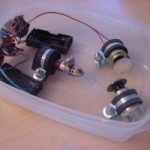 What happens when you shine a laser beam onto a spinning mirror? In the Laser Maze experiment, the mirrors stayed put. What happens if you took one of those mirrors and moved it really fast?
What happens when you shine a laser beam onto a spinning mirror? In the Laser Maze experiment, the mirrors stayed put. What happens if you took one of those mirrors and moved it really fast?
It turns out that a slightly off-set spinning mirror will make the laser dot on the wall spin in a circle. Or ellipse. Or oval. And the more mirrors you add, the more spiro-graph-looking your projected laser dot gets.
Why does it work? This experiment works because of imperfections: the mirrors are mounted off-center, the motors wobble, the shafts do not spin true, and a hundred other reasons why our mechanics and optics are not dead-on straight. And that’s exactly what we want – the wobbling mirrors and shaky motors make the pretty pictures on the wall! If everything were absolutely perfectly aligned, all you would see is a dot.
Here’s how to do this experiment:
[am4show have=’p8;p9;p19;p46;p89;p99;p103;’ guest_error=’Guest error message’ user_error=’User error message’ ]
Materials:
- AA battery pack with AA batteries
- two 1.5-3V DC motors OR rip them off old toys or personal fans sold in the summertime
- keychain laser pointer
- clothespin
- two round mirrors (mosaic mirrors from the craft store work great)
- two alligator clip leads
- gear that fits onto the motor and has a flat side to attach to the mirror
- 5-minute epoxy (don’t use hot glue – it’s not strong enough to hold the mirrors on at high motor speeds)
**Note – if this is your very first time wiring up an electrical circuit, I highly recommend doing this Easy Laser Light Show first. It uses a lot of the same parts, but it’s easier to build.**
Here’s what you do:
1. Insert the batteries into their case.
2. Use 5-minute epoxy to secure the gear onto the round mirror.
3. Press-fit the gear-mirror onto the shaft when the epoxy is dry.
4. Make the motor spin using the alligator clips and the battery case.
5. Turn down the lights and fire up the laser, aiming the beam onto the motor.
6. Shine the reflection somewhere easy to see, like the ceiling.
7. Once you’ve got this working, add a second mirror like you did in the laser maze.
[/am4show][am4show have=’p9;p46;’ guest_error=’Guest error message’ user_error=’User error message’ ]
Advanced Two-Axis Laser Light Show
The second part of this experiment is for advanced students. What shapes can you make? Is it tough to hold it all in place? Then here’s how to create a portable laser light show:
Materials:
- Red laser pointer
- 3VDC motors
- 2 gears or corks (you’ll need a solid way to attach the mirror to the motor shaft tip)
- two 1” round mirrors (use mosaic mirrors)
- 2 DPDT switches with center off
- 20 alligator clip leads OR insulated wire if you already know how to solder
- 2 AA battery packs with 4 AA’s
- Two 1K potentiometers
- Zip-tie (from the hardware store)
- ½ ” or ¾ ” metal conduit hangers (size to fit your motors from the hardware store)
- 3 sets of ¼ ” x 2″ bolts, nuts, and washers
- 1 project container (at least 7” x 5”) with lid
- Basic tools (scissors, hot glue gun, drill, wire strippers, pliers, screwdriver)
Click here to download the Schematic Wiring Diagram for the Advanced Laser Light Show.
Download Student Worksheet & Exercises
Exercises
- How does the mirror turn a laser dot into an image?
- What happens when you add a second motor? Third?
[/am4show]
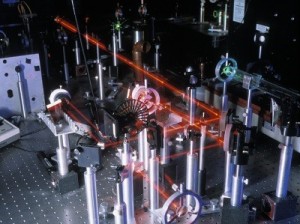 This super-cool project lets kids have the fun of playing tag in the dark on a warm summer evening, without the "gun" aspect traditionally found in laser tag. Kids not only get to enjoy the sport but also have the pride that they build the tag system themselves - something you simply can't get from opening up a laser tag game box.
This super-cool project lets kids have the fun of playing tag in the dark on a warm summer evening, without the "gun" aspect traditionally found in laser tag. Kids not only get to enjoy the sport but also have the pride that they build the tag system themselves - something you simply can't get from opening up a laser tag game box.
While real laser tag games actually never use lasers, but rather infrared beams, this laser tag uses real lasers, so you'll want to arm the kids with the "no-lasers-on-the-face" with a 10-minute time-out penalty to ensure everyone has a good time. You can alternatively use flashlights instead of lasers, which makes the game a lot easier to tag someone out.
This game uses a simple two-transistor latching circuit design, so there's no programming or overly complicated circuitry to worry about. If you've never built this kind of circuit before, it's a perfect first step into the world of electronics.
I've provided you with three videos below. This first video is an introduction to what we are going to make and how it works. Here's what you need:
NOTE: We updated this circuit in 2023 to reflect "best practices" when using transistors.
Be sure to build this project as shown in the schematic and breadboard diagrams, and not as shown in the video.
The material list below is based on the new design as shown in the schematic and breadboard diagrams on this page.
The videos show how to build the old circuit, but are still very useful.
[am4show have='p8;p9;p99;p103;' guest_error='Guest error message' user_error='User error message' ]
Materials (the list below builds one complete set per kid):
Materials (the list below builds one complete set per kid):
- Two AA battery packs with batteries
- LED (any color)
- 51Ω resistor
- 10KΩ resistor
- 1KΩ resistor
- 470Ω resistor
- NPN transistor (2N3904 or 2N2222)
- PNP transistor (2N3906 or 2N4403)
- CdS Cell
- Optional: N/O pushbutton switch
- Breadboard OR soldering equipment (including wire strippers, diagonal cutters, solder...)
- Flashlight or red (NOT green!!) laser
Flashlight Laser Tag Schematic:
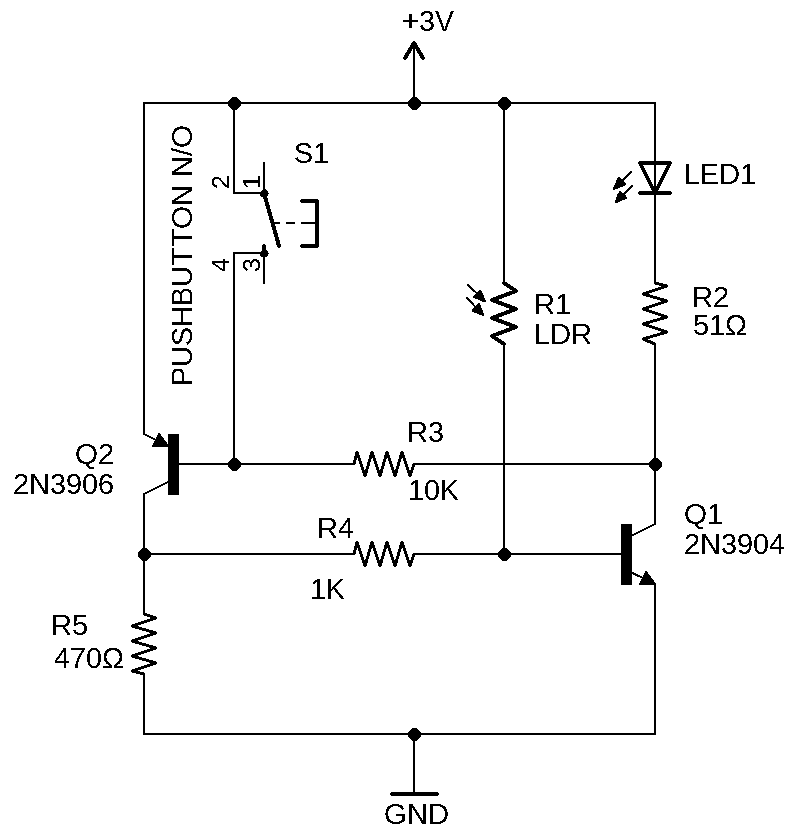
Flashlight laser tag breadboard diagram: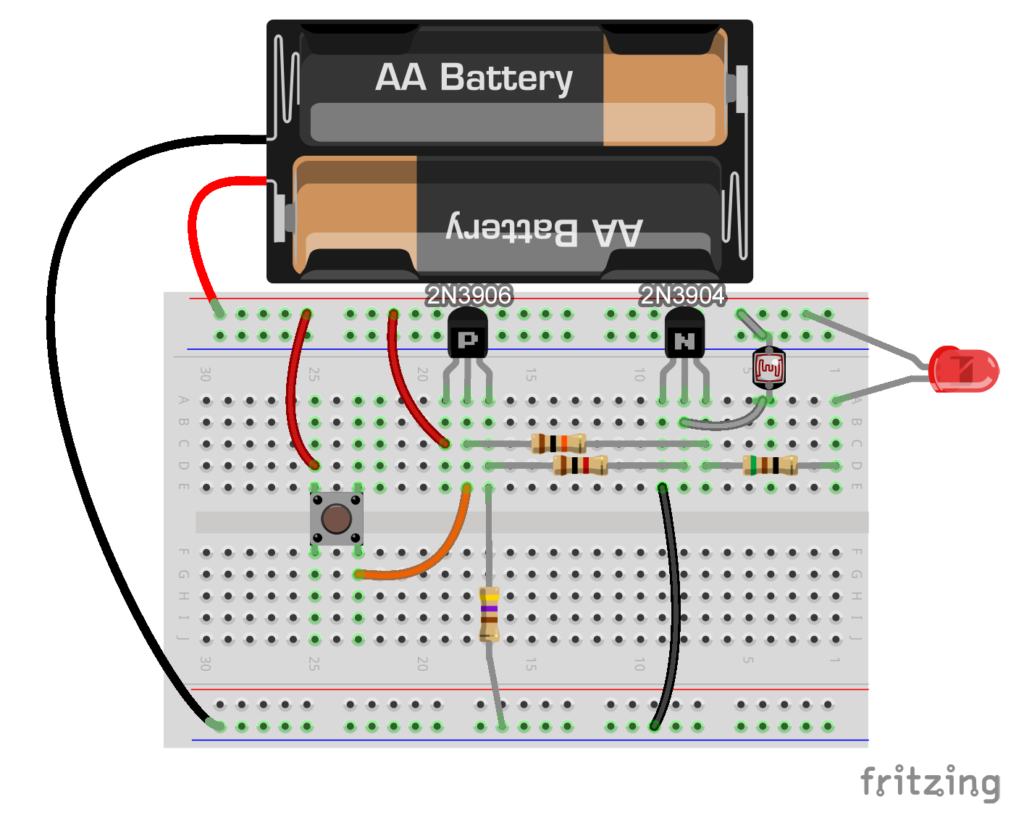
Introduction to the Circuit
The next two videos below show you how to build the circuit, first on a breadboard, and then how to solder the circuit together, so you can opt to watch either one. If you have someone who's handy with tools and soldering irons, invite them to build this with you.
Building the Circuit on a Breadboard
Soldering the Circuit Together
You'll need one of these circuits for every player, although you can get by with one kid having a flashlight (this is the "it" person) and the other running around wearing the circuit trying not to get "tagged". You can mount these circuits inside a soapbox or cardboard box with the sensor and light peeking out. Add a belt or wrist strap and you're ready for action!
[/am4show]
Wouldn't it be nice to wake up your brother or sister using an alarm you build yourself, triggered by natural sunlight? The happy news is now you can, using your Flashlight Laser Tag circuit you already built!
Since your circuit is already sensitive to light, you can transform it easily into an alarm clock that will buzz or light up when hit by the sun's rays.
Note - you can also use your Laser Door Alarm for this as well, since it's also triggered by light. However, the Burglar Alarm will not work, because it gets triggered by darkness, so unless you want your alarm to sound just as your drifting off to sleep, you'll want to use the Laser Door Alarm or the Flashlight Laser Tag circuit. Here's what you need to know (it's really simple...):
[am4show have='p8;p9;p99;p108;' guest_error='Guest error message' user_error='User error message' ]
Materials:
- Sunlight
- Window
- Laser Door Alarm or Flashlight Laser Tag Circuit
[/am4show]
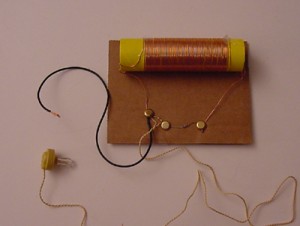 In addition to laser experiments, I thought you’d like to learn how to pick up sound that’s traveling on a light wave. A crystal radio is among the simplest of radio receivers – there’s no battery or power source, and nearly no moving parts. The source of power comes directly from the radio waves (which is a low-power, low frequency light wave) themselves.
In addition to laser experiments, I thought you’d like to learn how to pick up sound that’s traveling on a light wave. A crystal radio is among the simplest of radio receivers – there’s no battery or power source, and nearly no moving parts. The source of power comes directly from the radio waves (which is a low-power, low frequency light wave) themselves.
The crystal radio turns the radio signal directly into a signal that the human ear can detect. Your crystal radio detects in the AM band that have been traveling from stations (transmitters) thousands of miles away. You’ve got all the basics for picking up AM radio stations using simple equipment from an electronics store. I’ll show you how…
The radio is made up of a tuning coil (magnet wire wrapped around a toilet paper tube), a detector (germanium diode) and crystal earphones, and an antenna wire.
One of the biggest challenges with detecting low-power radio waves is that there is no amplifier on the radio to boost the signal strength. You’ll soon figure out that you need to find the quietest spot in your house away from any transmitters (and loud noises) that might interfere with the reception when you build one of these.
One of things you’ll have is to figure out the best antenna length to produce the clearest, strongest radio signal in your crystal radio. I’m going to walk you through making three different crystal radio designs.
You’ll need to find these items below.
- Toilet paper tube
- Magnet wire
- Germanium diode: 1N34A
- 4.7k-ohm resistor
- Alligator clip test leads
- 100’ stranded insulated wire (for the antenna: option 1 or option 2)
- Scrap of cardboard
- Brass fasteners (3-4)
- Telephone handset or get a crystal earphone
Here’s what you do:
[am4show have=’p8;p9;p84;p99;p103;’ guest_error=’Guest error message’ user_error=’User error message’ ]
[/am4show]

